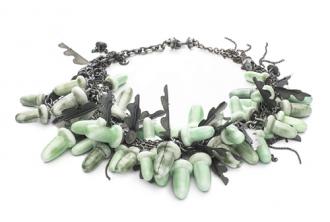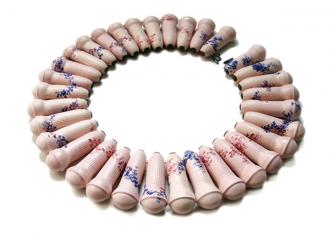
This show will travel on to venues in the US, Thailand, China, and the Netherlands.
Susan Cummins: When did you two meet?
Peter Hoogeboom: We met some years ago in France, when the first edition of the exhibition Un Peu de Terre sur la Peau was shown in Limoges. We stayed in the same hotel there, so we talked at breakfast and also did things together during the days, apart from the exhibition things. For instance, we went to a cemetery known for its porcelain decorations and plaques on the graves. (Limoges is the porcelain city of France.) Shu-Lin decided to visit me after I returned home, so a few days later I showed her around in Amsterdam. When the show went to Taiwan at the end of 2011, Katja Prins and I were invited to attend, and Shu-Lin showed us around in Taipei.

This show will travel on to venues in the US, Thailand, China, and the Netherlands.
Susan Cummins: When did you two meet?
Peter Hoogeboom: We met some years ago in France, when the first edition of the exhibition Un Peu de Terre sur la Peau was shown in Limoges. We stayed in the same hotel there, so we talked at breakfast and also did things together during the days, apart from the exhibition things. For instance, we went to a cemetery known for its porcelain decorations and plaques on the graves. (Limoges is the porcelain city of France.) Shu-Lin decided to visit me after I returned home, so a few days later I showed her around in Amsterdam. When the show went to Taiwan at the end of 2011, Katja Prins and I were invited to attend, and Shu-Lin showed us around in Taipei.

Peter Hoogeboom: It was Noel who proposed the idea of a joint exhibition about two years ago. The idea to really collaborate in order to bring our work closer came from our mutual friend Monika Brugger, the curator of the exhibition mentioned above. We arranged artists-in-residencies in both Taiwan and the Netherlands. During the first months of 2013, I lived with Shu-Lin in Treasure Hill Artist Village in Taipei, where we shared a small apartment/studio. The last two months of 2013, Shu-Lin came to Amsterdam, lived in Studio Rian de Jong, and we worked at my place where we also had an intern from the Rietveld Academy, Bram Wouters.
How did it work?
Peter Hoogeboom: The first part of our collaboration was in Taipei, where we went for hunts into the city to find ideas and materials to work with together. We collected fruits and veggies unknown to me but typical Asian/Taiwanese. Taiwan is a major producer of plastics and rubbers, so we came home with all kinds of hoses and tubes and with dotted and patterned rubber finger frocks and thimbles. We started playing with them—slicing, sawing, and cutting in them, combining them. The finger cots were especially interesting. Incorporating them in our stained slip-casting methods, they gave nice patterns on and in the elements we poured. In fact, we shared the same worktable and space, so we learned a lot from each other’s routines, and we shared tips, tricks, materials, and tools. Also in Amsterdam, we worked at the same table.
Peter, how did you find your way to making jewelry?
Peter Hoogeboom: I applied to several art academies with a portfolio of graphic work. I planned to become a graphic designer, was accepted as such, and chose to go to the Gerrit Rietveld Academie in Amsterdam. During that first year of basic studies, I discovered that I liked three-dimensional work better than two-dimensional work. During a classmate’s talk on contemporary jewelry, I became aware that the Gerrit Rietveld Academie had a small department hidden at the end of a long corridor. What I saw there struck me. I was so enthusiastic by the beautiful work and by jewelry’s versatility, many possibilities, and the use of many materials. In fact, it seemed to be the most free and autonomous area of all the design fields. For instance, I just loved the work of LAM de Wolf, and I realized that I could have control of all the steps in the creative process. Also, I liked the scale of jewelry and other objects. Many people think I have a background in ceramics, which I don’t.

Three years after I graduated (1992), I started to work with clay. Because I didn’t know anything about it, apart from making things with clay in
Primary school, I took several courses and workshops. Then, I bought my own kiln and all the tools and materials needed. Even now, when I need them or feel the need for inspiration, I still attend workshops to learn about new ceramic techniques.
Shu-Lin, what is your background?
Shu-Lin Wu: I received my BA from the Fu-Jen Catholic University in Taiwan in applied art, specializing in metal and jewelry. Before I entered this school, I already knew that I was a “hand person,” and that I preferred to make things with my hands, so I didn’t choose graphic design or some other part of this department. After university, I went to France and continued my study of contemporary jewelry at École supérieure des arts décoratifs de Strasbourg. That was the eye-opening period in my life when I started to get to know about contemporary jewelry, and I became more and more enthusiastic about it. I spent five–and-a-half years in France, including a year studying language, four years at the art school in Strasbourg, and a half–year internship in Paris. During my studies in Strasbourg, I also went to Lappeenranta (Finland) and Limoges (France) as an exchange student. These two experiences were both very important to me. The six-month exchange in Finland in 2006 taught me stone-cutting techniques, which expanded my ability to deconstruct/construct my work. Also, the philosophy of life and the relationships in Scandinavian countries really impressed and fascinated me—the respect for privacy and the beauty of silence and purity.

In 2007, I started to use ceramic material in my work. I didn’t have much of a ceramics background and had only had one semester of a basic ceramics course. I actually learned most of my techniques in France, and especially in 2008 when I went to Limoges to learn more about porcelain and slip casting techniques. This has become the main process I use today (also the technique Peter mostly uses).
Can you comment about the erotic nature of the forms you used to create these pieces?
Shu-Lin Wu: We decided to use the latex finger cots and the small objects we discovered in the streets of Taiwan as the start of our collaboration. We started to play, to cut, and to rebuild our own elements with them. At that time, I noticed that the texture of the latex/rubber material gave an erotic quality to different shapes. And later, when I went to Amsterdam in the winter of 2013 to continue the collaboration, these elements suddenly made more sense to me. Maybe because erotic forms relate to a common image people have of Amsterdam. I tried to create a complex atmosphere in my pieces, located between aesthetics and eroticism and tradition and modern themes.

Peter Hoogeboom: We were looking for words that would capture the works coming from our collaboration and also with our previous bodies of work. The GCC (Greenware, Crockery, Chinawear) exhibition will be in three parts—a selection of previous works of Shu-Lin, of me, and the pieces done working together. When we got to know each other and our work, we noticed we both use slip casting techniques most of the time, and we work with stained slips. There are European elements in Shu-Lin’s work because she was partly trained in France, while there are Asian influences in my work because I traveled a lot in Southeast Asia and China. Also, we preferred words that would have multiple meanings. “Greenware” means unbaked clay, but it also refers to the natural elements and influences in our work. “Chinawear” sounds like chinaware, which means ceramics or porcelain, but it is written differently at the end, referring to ceramics to wear and having to do with China. (Taiwan has a primarily Chinese culture.) “Crockery” could mean earthenware or tableware and also seems to refer to the sound of earthenware. Usually, but not always, I work in earthenware and Shu-Lin works in porcelain. In our collaborated pieces, we also swapped materials. I now get porcelain from Taiwan sent over by Shu-Lin.
I understand that this show will travel to a number of locations around the world. Was that something you worked on, or did someone else make those arrangements? How did it work?
Peter Hoogeboom: The show will travel to several locations around the world. We worked on the itinerary ourselves. Shu-Lin already had contacts at some venues, and I did in others. We were both already showing at Galerie Noel Guyomarc’h, and so the exhibition starts there.
What have you read, seen, or heard lately of value that you would like to recommend?
Peter Hoogeboom: I have always been a great fan of the work of Francis Willemstijn, and her new series is so beautiful. Also, I love the work of Terhi Tolvanen.
I recommend:
- That you never stop making things because, once you stop, it is very hard to get going again.
- Keep the inspiration flowing.
- If it is hard to get inspired, stop making an effort. Start vacuuming, cleaning the toilet, doing the dishes, or anything else, and new ideas will pop up by itself.
- Take a workshop in a completely different design field or art technique. I think the most interesting works are to be found or made in overlapping areas.
- Once you start engaging in something completely different, you also start to think outside of the box.

Shu-Lin Wu: I am always interested in the subject of culture. Last month, I saw the exhibition of Chinese artist Xu Bing at the Taipei Fine Arts Museum. His works engage in critical thinking about the written word and other tools of communication, the nature of art and civilization, and similarities and conflicts among different species and cultures. It’s really fascinating.
Recently, I participated a workshop of German jewelry artist Franz Bette. He just finished his two–and-a-half years teaching in Hong Kong, therefore he understands how a busy life and the Asian society can effect and challenge the Asian artist. By sharing his own experience, he reminded us to slow down, to always go back to the “zero point” of ourselves. Also, I like his recent work very much, which he made during his time in Hong Kong with very limited facilities and materials.
Peter Hoogeboom: Shu-Lin and I were just having breakfast and talking about your last question—things that interested us that we would like to share.
I remembered something else that really blew me away. I saw it in the Museum of Contemporary Art in Taipei. It was so beautiful that it stayed in my mind for weeks. I entered a completely dark room there. It was silent, and you could only hear the sound of a small toy train following a track laid out in that room. In front of the train was an LED light, which illuminated all kinds of very ordinary objects placed along that train track: pegs, pencils, a wire basket, a plastic sieve, and dominoes. The shadow play on the walls of the room were mesmerizing, enchanting, hypnotizing, meditative … I don’t know how to describe it. The work is called The Tenth Sentiment by artist Ryota Kuwakubo. People stayed in the room for a long time. We were all so quiet.
Thank you.




